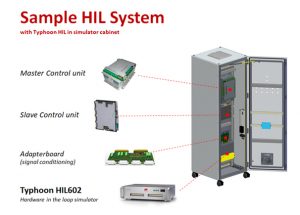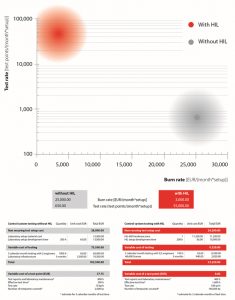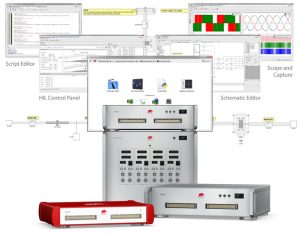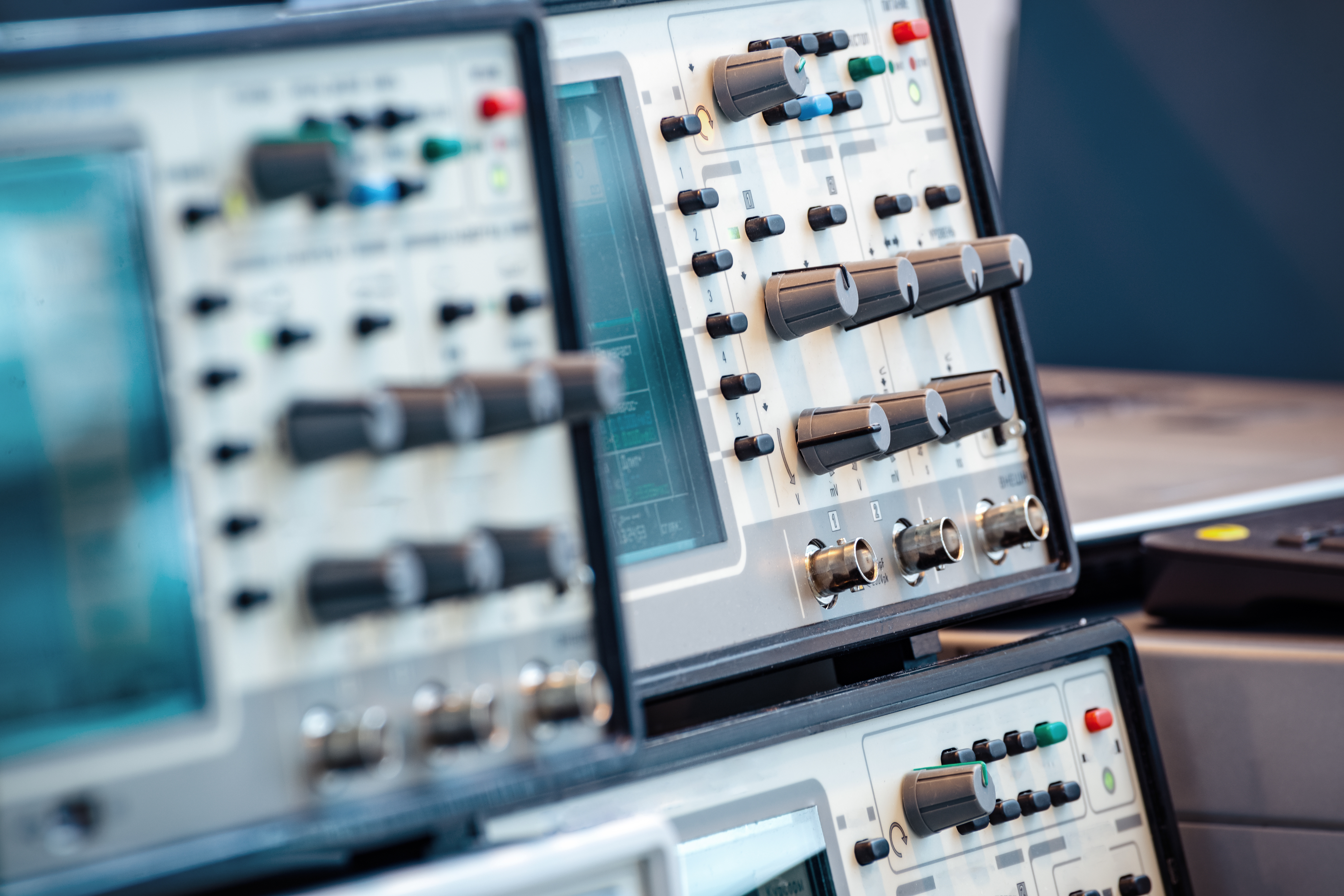What is HIL in power electronics?
HIL, short for Hardware In the Loop, is often associated with taking a device under test (DUT) to a lab, powering it on and assessing its performance in various scenarios, such as steady state, transients, and different supply system malfunctions, e.g. short circuits, power sags, etc.
In this, traditional, view of HIL, the power used for testing the DUT is real. The hazards to which engineers are exposed are real, too. Finally, the damage to a DUT prototype, when it occurs, is real, as are the costs of repairing or producing a new DUT prototype. Therefore, this approach is often called P-HIL, short for Power-Hardware In the Loop.
In power electronics (PE), however, HIL may refer to a different methodology. Namely, In PE, where the focus is on control, the traditional, P-HIL, methodology for testing should be only the final stage in the product development cycle. The ideal HIL approach, conversely, for most of the power electronics development cycle is what some call C-HIL (Controller-Hardware in the Loop), which is the meaning of the acronym as used in the reminder of the article. This means that a real controller- a PCB (not the entire device) is connected to a real-time model of the power stage. In short, the controller, together with its embedded software/firmware, is “fooled” into believing that it controls real power, but is actually interfaced to a high-fidelity real time emulation of the power stage and/or grid.
Ultimately, HIL allows direct insight into the behavior of control software, devoid of any hazards, damage and costs associated with testing in a power lab. A HIL system, which makes this possible, comprises a real-time hardware emulator with I/O to connect the controller(s), on the one hand, and modelling, control, and automation software, on the other (Fig. 1).

Figure 1: Components of a typical HIL testing setup, as used for development of smart inverters
Who should be using HIL in development and production?
HIL is a perfect match for PE engineers developing fast-switching systems, such as different converter topologies, e.g. inverters for PV systems, but it would be unwise and short-sighted to see its benefits restricted only to these applications. If seen for what it is – a control-focused improvement for pre-existing testing and R&D workflows, and not a replacement for everything that was used before – its benefits and reductions in OPEX are sure to resonate beyond the converter/inverter domain, and to go throughout the enterprise and even beyond traditional PE areas.
More specifically, in addition to PE engineers developing converters, HIL is also extremely useful to microgrid engineers, shipboard-power system engineers, system integrators, and is also guaranteed to be a life-changing tool for QA engineers. Additionally, HIL is the best productivity hack for every engineer who finds it increasingly difficult to make sure that new control software/firmware updates of power devices meet standard-based certification requirements such as those issued by BDEW or UL.
Additionally, HIL is also becoming indispensable for all electric vehicle (EV) applications, whether the EV is terrestrial (e.g. automotive – a car, or transportation – e.g. a next-generation train), marine (UMSs), or airborne (UAVs). At this point, some may object to this claim by saying that the engineers working on vehicles were the first ones to embrace the concept of HIL as early as in the 90s. That is correct. However, the HIL systems employed in such applications are focused on controllers of mechanical systems, where the emulation timestep of 1 millisecond (ms) is sufficient. Fast-switching PE systems used in EVs, such as kinetic energy recovery systems, fast chargers, battery management systems, etc., require HIL systems that operate on a completely different timescale: the HIL systems from the domain of PE, capable of timesteps as low as 1 µs, or even 500 ns. In short, EV engineers who expand their current HIL systems with the addition of power-electronics HIL (i.e. C-HIL) can expand the scope of their HIL testing beyond mechanical systems and include the fast-switching PE devices into their test coverage, thus creating true digital twins of their vehicles.
Finally, from the organization point of view, HIL is a perfect tool for onboarding and the common ground for functional integration of geographically-distributed, multi-department projects in large companies and/or enterprises. Thanks to its zero-risk environment based on virtualized power, HIL facilitates rapid staff turnovers, agile product development and efficient onboarding, because new engineers can quickly get familiar with pre-existing products and solutions and learn how they work in an interactive way, where the effects of changing every line of control code can be immediately seen by means of real-time HIL testbeds and HIL SCADA. HIL also provides a solution for geographically distributed teams working on complex projects, because every team can use the same platform (low initial cost at low risk) to immediately see the effects of their contributions to the overall system, before committing the changes.
All this may sound too good to be true, but, as engineers who have embraced the HIL methodology will tell you, it gets even better, because HIL ultimately makes engineering work less stressful and provides a way for safe and quick experimentation with new ideas and alternatives approaches. High quality power products need extensive testing. Testing the power products has high energy costs, high infrastructure costs and high failure risks. Read on for detailed benefits of HIL based on actual use cases by HIL users.
What are the benefits of using HIL?
The introduction of the HIL paradigm brings about one or more of the following five benefits: enhanced test coverage, streamlined product certification, lower R&D costs, simplified system integration, improved product, and, ultimately, lower OPEX.
Enhance your software control test coverage
The biggest, overarching benefit of using HIL and the emulated power stage is that it enables engineers to focus only on control and make the controller completely bug-free and fully optimized, before even starting tests with real power in a fancy and spacious power lab. This, by the way, is the most logical approach to power electronics development: test with real power only once you are confident that the software which controls it is error-free (or at least fatal error- free). In other words, by adopting HIL in all the stages of the development pipeline leading up to physical testing, engineers can extend be absolutely confident that physical testing with real power will be successful, or, at least, that no software-related hazardous control issues will occur during tests with non-emulated, real power.
Benefits of HIL extend beyond product development, as HIL caters to the entire product life-cycle by enabling rapid product upgrades and streamlined regression testing of control software. More specifically, when the only updates that must be made to the product are software-related, new versions of control can be tested exclusively in the real-time HIL domain, without costly, lengthy and potentially risky procedures involved in physical testing. For example, with HIL it takes about 90 seconds to power up the inverter controller with an emulated load, reach the steady state, insert a disturbance, measure the response of the inverter with the emulated power and turn the controller off. The test sequence for assessing the response takes the same amount of time as with the real setup, because the controllers are real, and the test is run in real time. Time and cost savings come from the fact that there is virtually no setup time, no MWs of real power consumed during testing, no (potential) damage to DUT, and from the fact that testing can be conducted in a fully automated fashion with absolutely no need for operator involvement. This is particularly useful when introducing a product, e.g. a solar inverter, into a new market requires slight modifications to the software because of local laws, regulations, or country-specific certification standards.
Lower R&D costs for complex systems by using HIL
Yet another benefit of HIL testing is automated testing of complex systems in an unattended manner. More explicitly, with language agnostic APIs, such as RCP API based on JSON-RCP 2.0, and with support for standardized protocols, such as IEC 61850, Modbus, DNP3 and OPC UA, controllers can be tested in a fully automatic mode with no human supervision while interacting with diverse physical equipment, such as relays, and third-party software suites, such as SCADA systems or plant management systems. In this manner, the controller software can be tested in actual, working systems with real, working system components, but without any dangers to the operation of the actual system. This significantly lowers R&D costs as the engineers can focus on solving actual engineering problems, while the automated HIL system generates detailed reports on the performance of their solutions during overnight testing, i.e. outside engineers’ working hours.
Simplify system integration
When paired with scalability, full automation and communication capabilities are also immensely valuable to system integrators, where HIL brings the benefit of making the process of integrating diverse components quicker, smoother and more efficient. Namely, system integrators, if they have a scalable HIL solution at their disposal, can take diverse controllers of diverse devices and interface them to the same real-time model of a power stage (e.g. a microgrid, or a shipboard power system). Then, by focusing exclusively on the controllers, integrators can fully optimize the interoperability of diverse components and be sure that the system is going to work flawlessly once commissioned – and do it before the devices are even installed at the microgrid site or into a ship.
Improve your products with HIL
Ultimately, HIL allows engineers to automate collection of thousands of data point and assess the behavior of their control software in every operational scenario imaginable, but in the safety of real-time emulated power, without complicated procedures, high costs and hazards inherent to testing with real power. From the point of customers, HIL leads to better products, because engineers can find and fix bugs that no one has previously even been aware of. From the point of manufacturers, HIL makes product development more efficient, simplifies regression testing and also streamlines in-house certification processes for diverse existing and emerging standards, making sure that the product is not restricted to a single geographical market.
Bottom-line of using HIL: lower OPEX
When the aforementioned benefits of HIL are taken together and analyzed from the financial and managerial point of view, the introduction of HIL methodology is sure to significantly lower OPEX (Fig 2). More specifically, enhanced test coverage means that bugs and issues are identified early in the product development cycle, so that there are no costly urgent fixes or recalls. Streamlined product certification means that the product can be sent to the certification body with full confidence that it will get certified in the first attempt, without expensive, prolonged certification processes in multiple attempts. Paired with automated, unattended testing, these HIL benefits do not only lower the R&D costs, but also lower the support costs as the products are inherently better and more optimized. In sum, lower OPEX, in the case of HIL, also leads to better customer satisfaction and makes globalization of products easier.

Figure 2: Lowering OPEX by using HIL for control system testing (example)
Are all HIL testbeds the same?
To reap all the benefits of the HIL methodology, engineers must have a proper HIL testbed. Despite seemingly small differences among offerings from different manufacturers, not all HIL systems are the same. “The devil is in the detail”. The abovementioned gains of HIL methodology are available only from a HIL solution which is vertically integrated, scalable, customizable, and reliable in its performance. Vertical integration means that engineers should be able to immediately start using their HIL system without spending months troubleshooting interoperability issues among different components of a HIL system. To put it differently, vertical integration is possible when the entire HIL system, meaning hardware emulators and I/O docks and modeling and control software, is from the same vendor and offers a true turn-key user friendliness devoid of third-party software and hardware complexities. Scalability means that a HIL system should be expandable, so that engineers can simply add additional HIL emulators when they go beyond testing individual controllers, and need to emulate complex systems such as feeder microgrids. Similarly, customizability implies that the HIL system can be modified to interface with any controller, providing a true black-box approach to testing. Finally, the HIL system should be reliable, in the sense that it should provide high-fidelity models of the power stage, be capable of achieving the same emulation timestep, e.g. 1 µs, for both simple and complex models, and be stable enough to run real-time emulation for hours, days, or even weeks, thus creating a viable alternative to prolonged periods of testing with real power and providing the benefits of lowering manufacturers’ OPEX.
The only HIL systems in the market that fulfill or exceed these requirements are those by Typhoon HIL (Fig. 3).

Figure 3: Vertically integrated HIL systems from Typhoon HIL: turn-key software and hardware solutions devoid of complexities of integrating third-party components into a testbed























